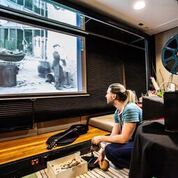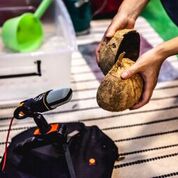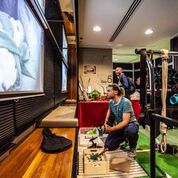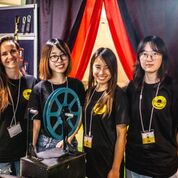CONCEPT: Sound making for a movie using everyday objects
Visitors will be provided with
- a screen on which the movie will be played
- a microphone to record the sound with
- a projector to play the movie as well as to choose the scene they want to make the sound for
- everyday objects to create sounds with
After deciding what/how to use the objects, they can then record the sound into the movie scene. Their work will be stored in the movie, and their names will be shown in the end roll along with the other visitors.
INTENDED EXPERIENCE: “Exploring & discovering sounds around us in an engaging and enjoyable way”.
To achieve “exploring & discovering”, Sound Studio provides opportunities for users the following actions;
- Paying attention to everyday sounds
- Revisiting the everyday sounds
- Looking at everyday objects differently (as a tool of making sounds)
- Being creative & Experimental to make the sounds
As a whole, we expect visitors to discover a new perspective of sounds in their own way.
Physical Form
As Sound Studio invites visitors to our story setting to achieve “engaging and enjoyable experience”, the esthetics is highly valued. The outlook is designed to communicate it is a theater, by using spider display board systems and 2 colors of curtains to build an isolated space, as well as hanging a film poster and placing a miniature film projector and a cup of popcorn at the entrance as a metaphor. It is also intended to make the installation outstanding in the exhibition space while making people curious about what’s inside.
Once visitors come inside, they will see a big screen and a projector in the center surrounded by so many everyday objects, along with microphones and tip cards.
Projector
The projector is made of MDF boards, and it has a handle, reels, and buttons. The handle is to play the movie forward and backward. This is enabled by attaching the handle to gears which rotate a rotary encoder connected to Arduino. The clicking of the rotary encoder and friction of the gears make visitors feel like as if they were playing an old film projector. Reels are attached to motors to rotate them along with the handle to visualize the interaction. Buttons are for clipping the fragment of the movie to make sounds for, changing the playing speed, saving and deleting the recorded sound. The interaction, different types of buttons, and the feedback they should return have been determined based on user testings. Though this projector does not actually project anything on the screen (it is projected by a real one attached to the ceiling), it should not affect the user experience negatively because the real one is placed outside of visitors’ sight.
Microphones
2 microphones are placed on the table and on the floor respectively, as some of the objects are easier to play on the floor. Each microphone has one button to start and stop recording, and the specific button has been selected to return ideal feedback by lighting up in red when it is ON.
Everyday Objects
So many different types of everyday objects are placed to achieve the intended experience of “discovery & exploration”. Objects have been collected based on the research of how to make sounds with everyday objects for particular scenes in the chosen movie. As for the display, it is intended to place them in a way it looks organized as a whole but it makes visitors feel even overwhelmed by the number of options they are provided. Also, a coat hanger with lengthy objects is placed to hide the controller space with computers so that visitors won’t be distracted.
Tip Cards
Tip cards are A5 sized cards, and they have been introduced to help visitors with coming up with ideas by providing pro-tips from foley artists, as well as to enhance the collaboration and engaging aspects by providing opportunities for visitors to write down their own ideas for other people to see.
Technology
This project involves a Unity-based program, electronic components that are connected to and controlled by Arduino, and an additional monitor to capture the resulting videos.
The Unity-based program is to be run on a big screen. The program enables visitors to play the video frame by frame to simulate the experience of films screening in the old days. This is achieved by exporting the chosen video into a sequence of frame images and showing them in order on a game object as its main texture. Meanwhile, the program takes audio recordings from two microphones and stores them into game objects, which are linked to the video through their starting and ending frames. The program also enables visitors to clip whatever scene they would like to add sounds to in a separate Unity scene so that they can return back to the original video at any time. Additionally, notifications will be given for user inputs, which are implemented by using UI elements.
Arduino receives inputs from electronic components, prints values to the program and then triggers corresponding functions. These inputs are mostly the activation of buttons, while the rotary encoder connected to the projector handle provides inputs the direction of rotation, to play the video forward and backward. Moreover, motors connected to reels are directly controlled by the rotation of the rotary encoder. The motors are to be turned on only when otary encoder is providing inputs, which means the projector handle is rotating.
Lastly, to present the collaborative results to visitors as feedback, an additional monitor is used to record the video shown on the main screen via OBS on a regular basis, then transfer the edited video recordings to a television and play.
Final Statement
Visitors Response
Based on the results of the exhibition, it was clear that Sound Studio delivered the explorative and enjoyable experience that the team aimed to achieve. While interacting with installation visitors were really engaged with the process: they strived to create numerous sounds for the chosen fragment trying out various everyday objects that were provided in the space. Visitors were also eager to continue the sound making process after they completed the sound effects for several fragments. In addition to that, the collaborative experience reinforced the interest: visitors collectively discussed which sound they aim to create, helped each other with the objects to produce more interesting sounds and enjoyed the results of the collaborative work together.
Positive feedback from the audience also confirms the success of the installation objectives. Visitors pointed out that the Sound Studio project was unique in a way that it provided visitors the experience of interaction not only with the particular product but with the installation as a whole. Visitors responded that the experience was engaging, playful, gave them “a new skill set” and a new perspective to the sounds that they face in their everyday life. In addition, it was visible that people return back to the installation taking their friends and kinds to work collaboratively in this space. Those who came the second time could not wait while the introduction part is over to start playing with new objects and sounds. It also appeared that people got an idea of the concept of the installation before actually interacting with it.
Affirmative feedback was also addressed to the aesthetics of the installation, the appearance of the space clearly communicated the theme of the concept and based on the feedback visitors immersed themselves in a completely different environment where they felt as in the workshop where they can experiment and be creative. It was also visible that the enclosed space by the curtains provoked curiosity as they tried to peek inside and lined up to interact with the installation.
Future work
Despite the positive response from the audience, several improvements can be implemented for the Sound Studio concept. Providing multiple microphones and getting several visitors to interact in a space at the same time made it difficult to record a clear sound. The system should provide simultaneous audio and visual feedback to the visitors when the recording was started to avoid extra noise in the background.
Physical interaction with the microphone can also be improved: some people found it difficult to press the button on the microphone to start recording while holding and manipulating with the object in both hands. At the same time, some visitors pressed the button for recording constantly which shows that the interface is not intuitive enough. A possible alternative can be replacing the button with a pedal which can activate recording by stepping on it.
In addition, visitors were interested in receiving results of their collaborative work after visiting the exhibition. Possible action to meet visitors needs would be posting the final video on Youtube.






